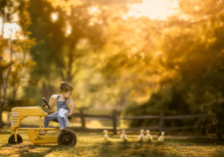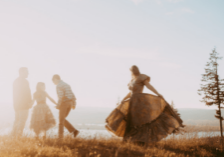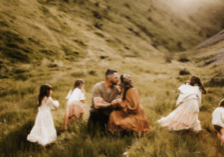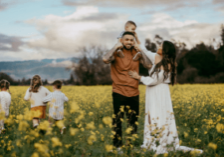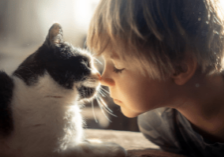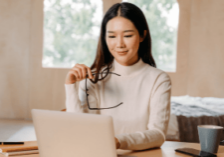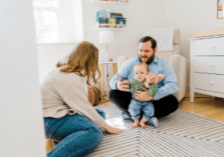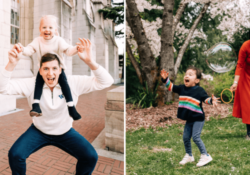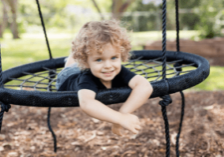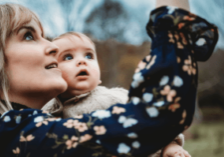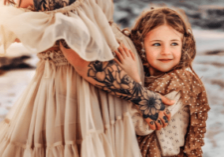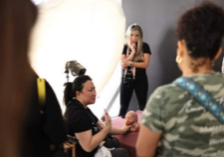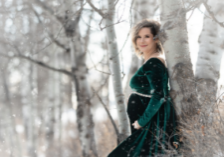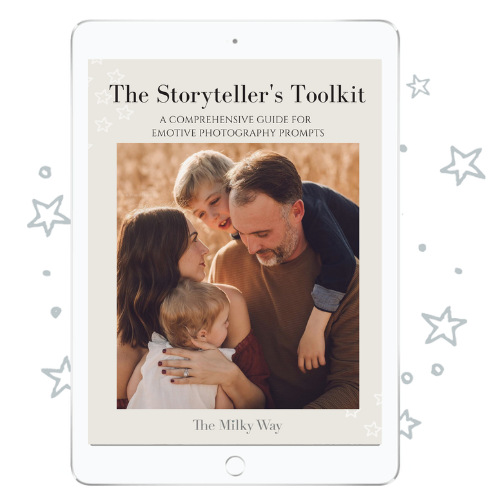The Business of Being Yourself: How Embracing Your Uniqueness Unlocks Your Creativity & Helps You Stand Out in the Newborn Niche With Natasha Simpson
As photographers, it’s easy to stifle our own creativity with self-imposed limitations – whether that’s working solely within one particular style or losing sight of how important it is to experiment and embrace new opportunities. But here’s the thing, you don’t have to confine yourself to any one particular box.
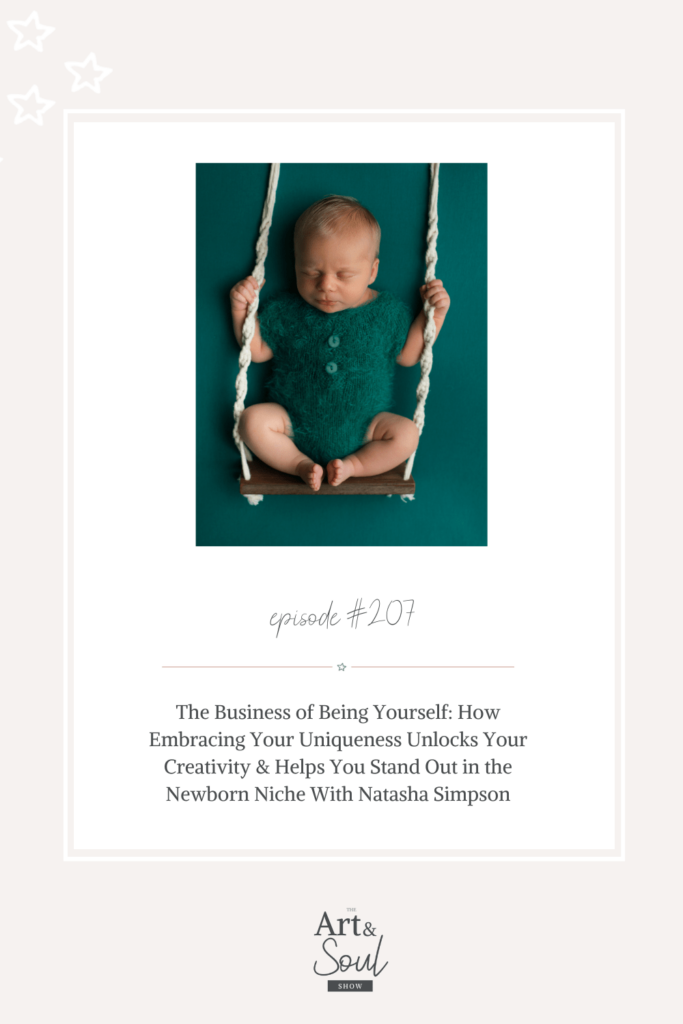
In today’s episode, I’m interviewing Natasha Simpson, a professional newborn photographer known for her fun, colorful work and her skill when it comes to incorporating elements such as florals and props. Not only does Natasha give herself full creative freedom, she has mastered how to use originality to her advantage. From strategies for staying organized, to standing out in the industry, to overcoming creative burnout in your career, you’ll hear it all on this episode!
So, get cozy, grab your notebooks, and tune in. I’m rooting for you, my friends.
What’s in this episode:
- [02:10] How Natasha manages being creative with staying organized
- [03:44] Natasha’s story and how she discovered the newborn niche
- [06:42] Incorporating a love for florals and props into photography
- [11:46] Advice on standing out and being unique as a photographer
- [13:40] Tips on balancing family and work and being 100% present
- [23:25] Overcoming creative burnout and how to get out of a rut
- [27:54] Experimenting and defining your own personal style
Tune in to this episode to learn how to embrace your creativity and stand out from the crowd.
SUBSCRIBE: Apple Podcasts | Spotify
Resources Mentioned
Meet Natasha Simpson
Natasha is known for her beautiful and colorful work and also the cutest outfits you have ever seen while doing newborn photography. She’s a talented newborn photographer located in Sanford Valley, Brisbane.
Connect with Natasha
Follow Natasha on Instagram
Did this episode provide you with a roadmap for becoming a newborn photographer? Check out this episode 10 Things I Wish I Knew When I Was Getting Started With Newborn Photography
Transcript
[00:00:21] Lisa DiGeso: Welcome to the Art and Soul Show, where we dive into heart opening chats on photography, business, life and that messy in-between. I’m your host, Lisa DiGeso, a mom, a photographer and entrepreneur, and I’ll be sharing honest conversations and advice for photographers with insight on mindset, entrepreneurship, and creativity. The goal of this podcast is for you to be able to gain insights and strategies that will get you real results. Because let’s face it, having a photography business can be lonely, but it doesn’t have to be. This is the place you can go when you need a boost of encouragement, a kick in the pants, and inspiration to pick up your camera. This is the Art and Soul Show. [00:01:03][42.3]
[00:01:08] Lisa DiGeso: Hello my beautiful friends. Welcome back to the show today. I’m super excited to dive into today’s conversation with Natasha from Dawn Photography. Now, you probably know her from her beautiful and colorful work and also the cutest outfits you have ever seen while doing newborn photography. She’s a talented newborn photographer located in Sanford Valley and that’s in Brisbane. I am so excited to dive into this conversation with her. So without further ado, here’s Tash. Welcome. [00:01:34][26.3]
[00:01:36] Natasha Simpson: Hi! [00:01:36][0.0]
[00:01:38] Lisa DiGeso: So can you share with us, who you are and what you’re super passionate about? [00:01:42][3.5]
[00:01:42] Natasha Simpson: Sure. Well, I’m Tash and. Oh, gosh, I’m a crazy creative photographer who loves all things handmade. And. Yeah, I have a studio. A commercial studio that’s usually pretty crazy and busy and always has things going on. I’m just super passionate about being able to do what I love to do every day. Just to be able to continue doing this is just makes me very, very happy. [00:02:08][25.9]
[00:02:10] Lisa DiGeso: I love it, and you are so creative because I’m always seeing in your behind the scenes you’re either doing balloon arches or you’re doing scenes of florals. So just tell it like how you keep everything organized. That’s like my number one question. [00:02:22][12.4]
[00:02:23] Natasha Simpson: No, it’s organized chaos. There is no set organization rule to me. I do this, I put things where I wherever they need to go. And then I just hope that I remember where I’ve decided to put them this particular time. I just always need to be doing something. I need to do something. And yeah, I love filming what I do to share that with people. I think also because I do so much, usually during the week, I needed to share that it was actually me doing it, which is always pretty. [00:02:54][31.3]
[00:02:54] Lisa DiGeso: Yeah. Yeah, yeah. I mean, like looking at the scenes like you’ve blown up on both TikTok and Instagram and like, and, but you’re behind the scenes are just fantastic and you’ve got these beautiful, organized, colorful spaces. But I’m always like, how does she do this? Because it looks like a bomb exploded in mine. [00:03:14][19.9]
[00:03:16] Natasha Simpson: It was time. Time? Oh, you’ve already seen what I show you. You know what I mean? Like I be sharing. I love my background wall that needs to be organized at all times. That’s very, very important to me. That colorful needs to be at least in color order. But everything else is just I have a whole shed that I don’t think I’ve ever showed in my business. Yeah, you’d probably walk in and be very scared. [00:03:39][23.9]
[00:03:44] Lisa DiGeso: I love that. I love that. So can you maybe share your photography story? How did you get into photography and how did you sort of find your way into the newborn niche and where you’re at now? [00:03:52][7.9]
[00:03:53] Natasha Simpson: Well, I have always done photography, and I know everybody says that they’ve always been terrific, but when I was quite little, I used to just absolutely torment my family with a Polaroid camera, and I used to just take photos of everybody brought up in their face. And then I think I was about ten maybe when I decided I was going to call it don’t photography. And I was just going to have a business. And I’ve had to stick with that name because I did it, you know, 20 years ago, 21 years ago. And my mom actually got me a few opportunities just to follow some photographers, when I was really young, I think maybe 15. And I was, able to follow a few photographers in the wedding world. So I started out doing weddings. And I’m, I am a people person. I love being out there, but I also like retreating to my yard space. So I did do wedding photography full time for a good few years when I originally started. And then, I just it just wasn’t. I was getting. I don’t know, I just couldn’t stick with it. I could it just felt like I needed to do more. I couldn’t just show up, do. The job and then leave. I needed to have something else, something that kept me busy a little bit more of the time. And after I had my daughter Ava, and she’s 11 now. So after I had her, she was actually in intensive care for a good I think it was about eight weeks, and I met some of the most amazing mothers in intensive care unit, and they were all talking about how their babies were too old to get newborn photos. And I thought, well, that’s a bit strange. That’s still a baby. You know, I could do that. It was all for my first few sessions. The terrible working with all the babies, as we all know, can be, yes, it’s challenging. And especially with babies who have had, you know, different health, things happen or surgeries or have a particularly rough start in life, can be extra challenging. So I actually started with elder newborns and learning how to do that. And, my husband was the one who told me I should really push into it because it was making me happy. I did try to give up about six months and I thought, I’m terrible for. You develop a donor, but I’m not going to do it. My husband’s like, no, no, no, keep keep at it. You can do it. So once I actually just decided, okay, yeah, I’m going to do it. We’re going to go for it. Newborns just became everything. So. Yeah, all the babies first and then to the younger babies. And then my, son was born. I, decided to convert my garage to a studio, so I had the home studio, which was amazing. But, yeah, it just it’s just gone from there. Just anything that I’ve decided to do on the business side, just go for it. [00:06:41][168.9]
[00:06:42] Lisa DiGeso: I love that. Now you have a love for florals as well, and you really sort of incorporated that love for florals really into your work. So how did you find to mesh that? [00:06:53][10.7]
[00:06:55] Natasha Simpson: I am lucky enough to hang out with some really cool creatives. I’m a part of a few women’s business groups and just having, you know, friends that I made in the wedding industry and a couple of my friends with florists. My mom always wanted to be a florist, and, I mean, I love flowers. I have a whole album sleeve there now, and I wanted to find a way to bring that in. So originally it started working. I started working with fresh flowers, so I actually made handmade flower wreaths, fresh flower wreaths, for newborn baby girls who had been in hospital for a little bit. And then it turned into just I just made these beautiful wreaths for anybody who requested it. And then, it just. Yeah, I just kept going with it. I did fresh flower everything until it just got very expensive. Yeah. And was probably costing more than it should have. So I switched to artificial about. About two years ago, I think. And now I do everything flower like I can reuse. And, you know, it’s just it’s, I originally was so against artificial, so I’m very happy that I swapped. Yeah. Came to my senses. But, yeah, I do everything floral. I make baby headbands and everything. So that’s what’s behind me here. All the dried flowers as well. So I don’t know. Just is. I have bright and happy. Makes me happy. [00:08:18][83.8]
[00:08:21] Lisa DiGeso: I love that. Yeah, well, it’s so funny because you can tell in your videos with behind the scenes, especially when you are working with the florals, how much you enjoy the creativity aspect of it and that really comes across in your behind the scenes. That it it really is a passion for you of merging those two together. [00:08:35][14.7]
[00:08:37] Natasha Simpson: Keeps them busy too. Have I mentioned I need to be busy? I don’t know what it is. [00:08:41][4.6]
[00:08:42] Lisa DiGeso: I know I had read that your hubby is a stay at home parent and came, in to help support you. That was actually my journey too, and we really experienced some growing pains that our family for a few years while we were figuring out sort of what our roles were. So my question is, what advice do you have for other photographers that are maybe looking to become their sole income provider? [00:09:05][23.1]
[00:09:07] Natasha Simpson: Well, goodness. My husband Adam is honestly very, very amazing. We met when I was 18 and he knew that I was very, very driven. And I was very fortunate that he was more than happy to just give up work and look after the kids. But, for us it’s it’s funny because his main roles, to, you know, take children to school and pick them up and make sure that we all have dinner. That’s very important, because otherwise somebody didn’t make me dinner. I just wouldn’t. You know, I’d be in this office all the time. My biggest thing I think for other people looking to do it is to make sure that you really have that understanding of what is about to happen. So sit down and and really discuss, you know, a few of the key roles that each person is going to do regardless of whatever they are like. You know, he he doesn’t like doing the washing. So I do the washing, you know, just figuring out the things that work for each other. He does like grocery shopping. So I’ll do the grocery shopping. He’ll do the cooking. Yeah, just stuff like that. So really have a good understanding of of what needs to be done to make this work. And we just need to be so flexible and just so understanding of each other. And if he needs time off or he needs a break, you know, to have that. So for us, it just kind of really, really worked. It just fell into place. I always need to do something. And he is more than happy to chill at home with the kids. So yeah hang out. So it just what I that. [00:10:41][94.3]
[00:10:42] Lisa DiGeso: But yeah it’s it’s funny because you don’t often hear well you’re starting to hear it more and more and I always I love talking to others that have been going through it too, because you’re exactly right. Because in the beginning, I would want to go do the things he would grocery shop, and then I would go to the store and pick up things, too. Yeah. He’s like, okay, like, you can’t do that. Like. I have a list, right? [00:11:04][21.9]
[00:11:05] Natasha Simpson: It’s funny because I think about it now. Like it’s been eight years. Yeah. We just. You just fall into it eventually. But it is tough. Yeah, it’s definitely interesting to begin with. [00:11:14][9.5]
[00:11:14] Lisa DiGeso: We’ve been I think it’s been about 11 years now for us. And I haven’t been to Costco in five years. [00:11:20][5.4]
[00:11:21] Natasha Simpson: Like, gosh, I’m only having it once in my life to Costco. I got so overwhelmed with everything you could buy. And my husband’s like, you know. We’re never taking you back. That like. Yes. No. Yeah, I agree. [00:11:32][11.7]
[00:11:34] Lisa DiGeso: My husband wants to go to Costco and he’ll take pictures of things he thinks I will like and send them to me and say, would you like me to get this? And then I’m like, sure, perfect. I love it. Yeah. So good. [00:11:45][11.4]
[00:11:46] Lisa DiGeso: Now, I love your cute and colorful rompers that you wear in social media videos that you must get asked over and over where you get them. So I love that you’ve really incorporated your own personal style into your social media, because it really does make you stand out. So what advice do you have for others struggling to maybe find their own way of standing out and trying to be unique to themselves? [00:12:08][22.2]
[00:12:09] Natasha Simpson: You know, it’s funny. So these overalls or, you know, rubbers or dungarees, whatever you want to call them, they started out because they’re something easy you can change if you get spewed on. Yeah. So I just take a romper off and put a new one on, like multiple times a day. So I usually shoot two newborn sessions a day. And then I realized that they, super comfy, like, wearing jammies to work every day. So honestly, it just fell into wearing. And I’m obsessed with color, so, I don’t I just feel like you’ve got to stop overthinking everything. You just need to do the things that make you happy. I spent the longest time trying to change myself and conform to everything, and it just is making me miserable. So the moment that I just decided to put all my social media out there, I just started to film and share what actually happens in my studio and I’m too busy to fake it so what you see on social media is what you say. Like, that’s that’s it. I’m too busy to make anything else up. I feel like you just got to let it go and go for it. Whatever you want to wear, whatever makes you happy. I used to read all that newborn photography, you know, forums, Facebook, and. And I’d go through what photographers should wear during a newborn shoot. And I just thought, well, that’s so boring. Like, why do I have to wear that? Why is my business? Am I not allowed to do this? So, yeah, I think you just got to not let yourself hold yourself back, honestly. [00:13:38][89.5]
[00:13:40] Lisa DiGeso: I love that. That’s good advice, I love that. So I want to ask, can you share any tips on staying organized and balancing your family and your work? [00:13:49][9.5]
[00:13:52] Natasha Simpson: I already said organized chaos. I think my biggest thing. And I was just thinking about this only recently, actually, because, you know, when you’re, you get a new inquiry and you’re already pretty busy. I mean, like, all right, it’s okay. I’ll take one more. It made me think on, you know, pre planning the things that you’ve got to do with your family. So, you know, having breaks over the school holidays and making sure you do things with the children and, you know, allowing that family time. So my big thing that I’ve realized is worked really well with my kids is, whenever we have family time, it’s family time. Whenever we’re going out to do something, it’s 100%. We’re going out to do something. I don’t pull out my phone or, you know, just one more email or just have to reply to this or, you just have to do the family. So you have to be 100% there. And especially because my children are older now, being seven and 11, I find that they need me to be present 100%. Whereas when they were younger and I was building my business, I was able to sit at the computer and still look over and talk to them. And you know, they’re okay. They’re doing something. It’s fine. They’re they’re engaged. Whereas now they want to have that conversation. I want to sit down and they chat. So yeah, being 100% there and fully engaged, with family during family time is very important. I work crazy hours. I do treat this as a proper full time job. I do go from 7:00 am till about 6 p.m. most days, and then edit a couple of hours when the kids are in bed. So anytime that I am not at work, I’m 100% present. [00:15:30][98.2]
[00:15:31] Lisa DiGeso: Yeah, I love that. Now, I know from previous conversations that you and I have had that you have a really efficient, workflow when it comes to editing your your process. Can you share how you sort of came up with that and how it’s been easier for you to take on more because you’re able to have an efficient workflow? [00:15:47][16.0]
[00:15:49] Natasha Simpson: Well, it’s one of those things with editing and workflows. There’s so much information out there and so many people do it in so many different ways. And I used to be very caught up with how I had to deliver my packages or whether you were IPS or, you know, a digital. What do they call it now? Shooting bird until so young. And I just do it the way that works for me. So my advice, you know, being comfortable with being able to shoot how many images I want to shoot and edit, as many images as I want to edit, and then have set packages that I deliver. So all my galleries and sessions, they all have a set amount of images that I sit down and, and what do you call it, cull through and then edit. So I don’t, let myself get carried away with that. I really stick to my limits and I know carried away. But it’s so easy to do when you have all these cute babies or these cute sessions. You want to keep taking photos. So I have gotten very, very good at trying not to overshoot, and, and really kind of knowing what I like. So only taking the photo and I know it’s going to work unless it’s, you know two year old running around my studio and then you just what. Do you shoot and pray? Yeah. You know, that’s fun. But when it comes to babies who are sleeping in this settled and natural I just, I try to really keep it to my limits. And then that way, my workflow works just as my shooting workflow in studio, my editing workflow is, is quite seamless as well, as long as I don’t overdo it and I, I think I’ve been doing this just for so long now that I just, I know when I’ve ever done it. And I could tell myself, Tashi, you ever did it. [00:17:29][100.2]
[00:17:31] Lisa DiGeso: For me, I know I’ve overdone it when I start resisting wanting to cull. Oh, yes. And I’m like that. What? I’m like, it’s almost like there’s too much to go through. So. And I’m like, you overshot again. That tells me, like, if it was easy, you’d go do it right away. Yeah. But because you’ve you’ve done too much. Yeah. You think it’s overwhelming because there’s too many choices. Yes. And my brain’s like, nope, not going to make any hits. [00:17:52][20.9]
[00:17:53] Natasha Simpson: I have to feel like editing as well. So that’s a big issue for me as I try to set these times. And I’m going to sit down and edit and it just never happens. And then I end up having these massive editing productive day. So I still get everything done within my timeline. But it’s always like I’m waiting to feel like editing. So sometimes you just have to sit down and do it, which is, yeah, that’s a challenge for me. [00:18:15][21.9]
[00:18:16] Lisa DiGeso: Yeah. One thing I had to really do was realize that I have a artist’s workflow and I have a photographer business workflow, and sometimes they can mesh, but it’s probably in my best interest if they stay separate because I am a fine art photographer through and through, and I want to spend like an hour and a half on one image. Yeah, yeah, that’s not really good for my business, right? Not the business model that I run. [00:18:42][25.3]
[00:18:43] Natasha Simpson: So gosh, I am like two minutes per image. I am yeah, I am sorry. Quick. But I have this big, big love of getting the photo right when I’m taking it, like just the newborn photography, everything else. I mean, honestly, I could, I could change and the pages. But if we’re talking newborn photography in general, I really love getting that, like, perfect, you know, taking the photo be like, oh, good, this only skin did it. Like it’s not. Yeah. Anything else? It’s almost like a challenge for me. Every background needs to be the right size. Every wrinkle that are wrinkles in my blankets, you’ll notice. Yeah. Very I don’t know. There are times that it’s just not like that. And it’s almost like every session I’m like, what else can I improve? Like how can I? Yeah. [00:19:25][42.1]
[00:19:25] Lisa DiGeso: I love that. I think when you go into your sessions instead of like and going through how do I get through this? It’s like, how do I make this better? Yeah. Like that keeps things fresh for you too. Absolutely. And you’re always like you’re adding something to like, that roster of. And then it becomes so easy for you eventually. Eventually takes. [00:19:44][18.6]
[00:19:44] Natasha Simpson: Yeah. And eventually. And it’s huge because that’s something that I really love. In the beginning I used to that used to be something bad for me. I used to be like, oh, I could’ve done that better. Like, that’s terrible. That shoots now ruined, you know, could have done that better. But now I think, oh, no, I could do that. That’s good to me. That’s great. Next time I do this, I’m going to take that thing that I was a little bit like. Oh. And turn it into. Oh great. Okay, so next time this is going to happen. It’s going to improve. It’s going to make things better. And then, you know, just makes me more excited. So. That comparison of yourself comparing. You know, it actually can be a good tool if you use it correctly. Yeah, yeah. [00:20:22][37.9]
[00:20:23] Lisa DiGeso: Yeah, I agree, totally agree. Now, what inspired you to switch? Because I know that you’re now in a commercial space. So what inspired you to make that switch? And what do you feel photographer is really need to consider if they’re considering a commercial space as well? [00:20:38][14.9]
[00:20:38] Natasha Simpson: So commercial for me, honestly, was that I got very busy very fast, which which is great. And if my husband wasn’t a stay at home father, I probably would have stayed at home for as long as I could. Because financially, with a photography business and especially being a very prop orientated business, as we all know. Very easy to collect props, very hard to maintain props. So yeah. Commercial was kind of just the next natural step for me to allow my family to have a family home. My house isn’t very big. It’s a full bedroom, you know, double car garage or one level, very versatile. There’s no way anybody can hide. And I felt myself getting a little bit frustrated just when the kids wanted to have fun in the lounge room, which is next to the garage. You know, it’s it’s it’s so close and you can hear outside noises. So, commercial was just the next, the next thing. But it is it is very it’s a big step. It’s definitely. Yeah, I’m in my second commercial building at the moment. So my first time, I think jumping into commercial straight away, getting your numbers right, making sure your business side of things is, is very important. So really understanding what your new outgoings are going to be. That was fun for me. I think my just after my first as what do we now five years I think commercial. So just off to my first year and a half Covid hit. So that was fun. So yeah, if I didn’t have a good understanding of my numbers and what I needed to bring in, it was it was just. Yeah, shooting in the dark. So, now I’m very, very comfortable. I know exactly what my outgoings are. I know exactly how many shoots I need to do to be comfortable to keep that studio. And it definitely is a creative space. Being able to step out of your home and have your own organized mess of awesomeness is fantastic. Instead of walking down the end of my hallway and being like, five guys just doesn’t work for me. [00:22:39][121.0]
[00:22:41] Lisa DiGeso: Yeah, totally. I love that you touched on knowing your numbers, because I think that’s so important because so many of us, and I know that I’ve gone through it where I’ve had years of overspending and not realizing that I wasn’t actually paying myself at all. I was just investing in more props. And that’s not paying yourself, right? That doesn’t buy groceries. [00:22:58][16.9]
[00:22:59] Natasha Simpson: I know overspending is Look, I still, I get so excited at every project. Somebody will come to me with something and it doesn’t matter. I’m going to make that happen. You know? I’ve got to buy it. So now I’m really trying. And my ultimate goal for this year is to make as many things by hand. So bring out the old papier maché. I’m going to make some stuff like yeah, really try. [00:23:24][25.1]
[00:23:25] Lisa DiGeso: I love that, I love that. So we all have moments I’m sure of creative burn out. So do you ever find yourself in a rut and how do you get yourself out? [00:23:34][9.2]
[00:23:35] Natasha Simpson: So I only just recently, over the Christmas period, had a massive, head towards the end of last year, early this year, just I think the amount of shoots that I did in one year, which was insane. I’m not even going to talk numbers. It was crazy. I, ended up, you know, I because I work so much, I don’t have as many, you know, people that I can talk to or hang out with. So having a few key people in your life that you can sit down and just vent with is such a key thing when you’re feeling burnt out. And usually they turn around and be like, oh, well, this this is the thing you’re complaining about the most. So this is your problem. So just having key people in your life and minds, my husband and my sister, and you know, I’ve got a best friend who lives in New Zealand who loves to let me. To vent and read. And, and she always turns her out of me like, all right, this is the one thing you’ve been complaining about for ages. You got to just push through it. You’ve got to just figure out what it is that’s really, really getting at you and make a change. And then you do start to feel better. But it’s okay to have those down periods. Everybody has down periods. It’s and sometimes it’s alright to cut back and just do what you need to do to, to get through. You don’t always need to be up and go, and that is a big struggle for me, just being able to be like, it’s okay. Not every session that comes in doesn’t need to have something brand new that, you know, I’ve never seen they’ve never seen it. It’s every session is brand new for them. They’ve all the photos are new for them. You know, I get caught up on having to, you know, create something new and, and that’s what causes my burnout. So just really, you know, having that chat and sitting down and being open, don’t hold it all in yourself. That builds up and usually leads to something not good. So just. Yeah, just me having my husband, who, I mean, you probably get sick of me ranting, but at least, at least I’ve got it. And you’ll tell me straight up what it is that I’m complaining about, so it’s good. [00:25:46][130.2]
[00:25:47] Lisa DiGeso: I love it. A few years ago, I well, I would do holiday mini sessions. Now I know that you do as well. And one year I had booked I thought self I think 87 holiday mini sessions and the burnout I experienced that year, I was like, I can’t do that to my self and my family ever again. Like. I just wanted to take my camera and throw it like smashed against a wall. And I was like I love photography. Like, who am I? [00:26:13][25.6]
[00:26:14] Natasha Simpson: I you know what? And it’s funny that you mentioned the Christmas minis because each year this is so my third year, the last like last year’s Christmas mayonnaise, I ended up with 111 Christmas minis, which I know sounds insane, but the first year that I did it, I wanted to start my camera at the little I was. I don’t know, I’m never going to do this. But then I looked at my husband and said, oh, I know how I can fix this. I know how I can still do this. So I, told him how to edit straight in the editing process for the Christmas minis while I did the shooting process, because the shooting itself, I can stand all day. And do you know, 20 families in a day? Easy. I’ve got systems down pat to to create what I want to create, but the editing side is what made me just like that screen was going to come off my desk and just go sideways because, yeah, I can’t sit anymore. But yeah, my husband, thank goodness he, he can edit. Actually, I that’s awesome. At first I would love if he would edit some more. That would be great. [00:27:21][67.3]
[00:27:23] Lisa DiGeso: I love it. It’s awesome. I never thought about teaching my husband to edit. [00:27:26][3.7]
[00:27:26] Natasha Simpson: But I mean, in the beginning it was I would come up and be like, oh, Adam, that’s. Yeah, maybe just for you edit that one. You know, I was a bit worried that, he would take that to heart, but he did really well. He did really, really well. Right. So it was good by the end of the shoot, you know, by the end of, Christmas minis in the editing process, I didn’t have to look over the photos. I was able and happy to send them. But I think the first, like 20 or 30, I was nit picking everything that I needed. So. [00:27:54][27.7]
[00:27:54] Lisa DiGeso: Yeah. So funny, I love that. So how would you describe your style as a photographer and your work? [00:28:03][8.8]
[00:28:04] Natasha Simpson: Oh, just just colorful. Let’s see. Anyway, I try to be colorful. I am falling in love with the neutrals more and more every day, but textured neutrals. So if it’s not the color, it’s still the textures. And, that overall, you know, creaminess of neutrals is really coming at me lately. But yeah, it just colorful. I don’t I try not to box myself into any set particular style. I do like to change things and experiment with things. So yeah, just keeping the color. [00:28:36][32.1]
[00:28:39] Lisa DiGeso: Love that. Now, what advice do you have for someone maybe struggling to find their own style? [00:28:42][3.0]
[00:28:44] Natasha Simpson: Don’t be afraid to try different things, to just experiment and continue. And don’t be, you know, boxed in when you feel like you found something or you go, oh, this is my style. Don’t commit to the bits straight away. Be like, okay, this is my style. It took me many years before I realized that my style was more how am I? Lighting was going to look like. That was my just lighting camera settings that okay, that’s my style, but what’s actually what I’m taking photos of constantly changes. But the lighting, if that makes sense, like that’s more of my my style of how I’m doing it. The flow is my style. That’s kind of how I do it that way, but not the actual outcome. Just like that one thing I’m taking a photo of, but just to to play around and then, you know, not to, try to have the same style for different types of shoots, you know, maternity, your outdoor work and your studio work is always very different. People try to match everything. Yeah, it’s okay to be different. It’s okay to have different styles. I’ve got a good friend of mine who’s a photographer who shoots in two different ways, so her family shoots. She loves it. So she gives people the option for her moody side or her light and airy side. And I love that that that works for her. And that’s how she. And I think it’s great. That’s just how she’s decided to do it, because there are no rules on how you do this. This is your business and whatever you want to call your style, you can call your style. Just go with it. [00:30:11][87.5]
[00:30:13] Lisa DiGeso: Love that. All right. Are you ready for our lightning round? Oh, sure. Okay. If you like to cook, what do you like to cook the most? [00:30:22][9.7]
[00:30:23] Natasha Simpson: I don’t cook, no one trusts me in the kitchen. [00:30:24][1.6]
[00:30:27] Lisa DiGeso: I love that favorite movie. [00:30:29][1.8]
[00:30:30] Natasha Simpson: There’s a movie called holes, and it’s a Disney movie. And don’t ask me why. I don’t know, I just love it. [00:30:35][5.0]
[00:30:36] Lisa DiGeso: Madame Zeroni. Oh. That’s awesome. What did you want to be when you grew up as a kid? [00:30:43][6.6]
[00:30:43] Natasha Simpson: Photographer. And stop work animation artist. [00:30:46][2.8]
[00:30:48] Lisa DiGeso: Oh that’s cool. Go to song that lifts you up when you’re feeling down. [00:30:53][5.0]
[00:30:53] Natasha Simpson: I have no clue. I just put my phone on whatever music comes on. [00:30:57][4.3]
[00:30:59] Lisa DiGeso: Yeah. I love that. Favorite. Guilty or not so guilty pleasure. [00:31:03][4.3]
[00:31:05] Natasha Simpson: I don’t know. Me making baby headbands for some reason. That’s like. It makes me so happy. Just. Yeah. And I keep buying flowers, so. [00:31:13][7.8]
[00:31:14] Lisa DiGeso: I love that. Do you sell them too? [00:31:16][1.8]
[00:31:16] Natasha Simpson: Yeah, I launched I launched a little shop last year that’s been really good. It’s just, it’s it’s funny because I put up all these phasing headbands. It took me hours and hours and hours, and then they all sold out. And then I got sad because they were all gone. Oh, no. When I get rid of them, I know. Yeah. So now I need to spend. Actually, it makes it. [00:31:38][21.4]
[00:31:41] Lisa DiGeso: I love that. Oceans are mountains. And why. [00:31:41][0.5]
[00:31:42] Natasha Simpson: Mountains? Because I don’t like the ocean. Because. See what you’re diving into. [00:31:45][3.4]
[00:31:48] Lisa DiGeso: It’s true. What’s your favorite comfort food? [00:31:51][3.2]
[00:31:52] Natasha Simpson: Oh, light and tangy chips. [00:31:53][1.4]
[00:31:56] Lisa DiGeso: Yum. Where do you feel most centered and happy? In my. [00:32:00][3.7]
[00:32:00] Natasha Simpson: Studio. It’s my happy place. [00:32:01][1.5]
[00:32:04] Lisa DiGeso: What are you most grateful for in this season of life? [00:32:06][2.2]
[00:32:07] Natasha Simpson: Just to be able to be doing this for as long as I have been doing. Especially with me being such a crazy person, doing everything, I’m so grateful that I found something that keeps me really happy. [00:32:19][12.0]
[00:32:23] Lisa DiGeso: I love that. What would your dream session be? [00:32:24][1.3]
[00:32:25] Natasha Simpson: Oh my dear. I don’t know. I don’t know. I already do, so like every day is like a dream session. I know that’s such a cliche, but I’m just honestly happy to be given what I’m given in interviews. [00:32:39][14.6]
[00:32:43] Lisa DiGeso: I love it. What would you do with an unlimited gift card for florals? [00:32:44][1.8]
[00:32:45] Natasha Simpson: Oh, gosh. You know, that’s really cool. Flowers. People say ceiling to floral flowers. Yeah. Yeah. I want to build one of those. Just be you walk in and be like, whoa. [00:32:56][11.4]
[00:33:01] Lisa DiGeso: Yeah. Love it. What has been the best piece of business advice you’ve ever been given? [00:33:04][2.6]
[00:33:05] Natasha Simpson: That if you don’t do it no one will do it. But then on the other side of that, don’t be afraid to ask for help. Which I find funny. Yeah. That’s true. [00:33:16][10.2]
[00:33:17] Lisa DiGeso: That’s good advice, actually. Now, what advice do you have for someone just starting out? [00:33:22][4.4]
[00:33:24] Natasha Simpson: Learn your camera settings inside and out. Read that manual. Super understanding your camera and its capabilities. Before you start getting worked up on style and everything else. You learn those camera settings and you’re lighting that. So key lighting is everything. It’s everything. Yeah. [00:33:41][17.6]
[00:33:44] Lisa DiGeso: Where can our listeners learn more from you? [00:33:46][2.0]
[00:33:47] Natasha Simpson: I am launching, a few key learning things on my website, so I have a little Learn With Me page on my website. And, that’s where I’ll be announcing lots of bits and pieces. [00:33:59][11.7]
[00:34:00] Lisa DiGeso: Yay, and you’re actually teaching with us for the online newborn retreat that starts, end of January. So can you share a little bit what, your presentations. [00:34:11][10.6]
[00:34:13] Natasha Simpson: I had the cutest, biggest little boy that I think I photographed at two weeks old. I think he was 4.7kB. So my workflow was. I show my workflow. But it was it was funny because he was so happy. Sorry. I actually had to change quite a few of the prompts at the last minute. So I guess we’re showing what we can achieve with, you know, completely unexpected. Giant baby comes in your door. But yeah. Workflow. Working with colors. He also didn’t fit in outfits, so it was so funny. But yeah, just just going thing. From one thing to the next, kind of incorporating a prop and taking out a prop and how you can change an image without changing baby. So making small changes that make extra images for a gallery. [00:35:01][48.1]
[00:35:03] Lisa DiGeso: Love it. Well, I’m so excited for our students to go through it because I’ve watched it myself and it’s fantastic. So I love to end my interviews just with this last question. And it is, what are you currently curious about or artistically curious about? [00:35:17][13.9]
[00:35:19] Natasha Simpson: What am I currently, doing? My, creative reels, like reels for Instagram. I’m really trying to level them up and actually doing them with a professional camera, so that’s been a challenge. I haven’t posted any yet because that’s incredibly hard to film yourself with an actual camera rather than just to fire. Yeah. So yeah, I’m trying to challenge myself and Levon leveling up social media. Just on Instagram. I’ve kind of dropped off the boat with TikTok a little bit, but yeah, yeah. So creatively, just trying to create a little bit more of a, more of a storytelling behind the scenes in my studio rather than, my current style. So yeah, playing around. [00:36:00][40.9]
[00:36:02] Lisa DiGeso: I love that. Well, Tash thanks for joining me today. It’s been a pleasure chatting with you. [00:36:06][4.2]
[00:36:06] Natasha Simpson: Thanks for having me. [00:36:06][0.0]
[00:36:06] Lisa DiGeso: Oh my beautiful friends, I hope you have loved this conversation just as much as I have. I am sending you so much of my light and my love today and every single day. We’ll see you next time. [00:36:06][0.0]
[2024.1]
share the love
[Sassy_Social_Share]
recent
Podcasts
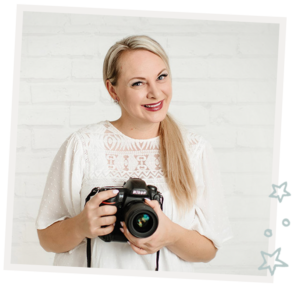
I'm
Lisa DiGeso
I’m on a mission to create uplifting online experiences for photographers ready to elevate their art, their business and their mindset.(...and have fun along the way!)



